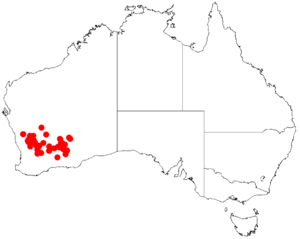Acacia inceana facts for kids
Quick facts for kids Acacia inceana |
|
|---|---|
| Scientific classification | |
| Genus: |
Acacia
|
| Species: |
inceana
|
 |
|
| Occurrence data from AVH | |
Acacia inceana is a type of shrub or small tree that belongs to the Acacia family, also known as wattles. It's special because it only grows naturally in one place: the southwestern part of Australia. This means it's endemic there.
Contents
What Does Acacia inceana Look Like?
This shrub or tree usually grows to be about 1 to 4 meters (3 to 13 feet) tall. Its branches are round and smooth, or sometimes they have fine, soft hairs.
Leaves and Flowers
Like most Acacia plants, Acacia inceana doesn't have regular leaves. Instead, it has special leaf-like parts called phyllodes. These phyllodes are always green and grow upwards. They can be straight or slightly curved. They are usually 4 to 8.5 centimeters (1.5 to 3.3 inches) long. They can be very thin, like a needle (1 to 1.5 millimeters wide), or a bit wider (4 to 6 millimeters wide) if they are flat.
The phyllodes get thinner towards the end, forming a delicate tip. This tip is usually curved and not sharp. The phyllodes are stiff and can be smooth or have fine hairs. They have many thin lines, called nerves, that run close together.
Acacia inceana blooms, or flowers, from August to September. It produces bright yellow flowers. These flowers grow in pairs where the phyllodes meet the stem. Each flower cluster is round, like a small ball, about 3.5 to 4 millimeters wide. Each ball has 10 to 30 golden-colored flowers.
Seed Pods and Seeds
After the flowers bloom, thin, leathery seed pods form. These pods are long and straight, and you can see slight bumps where each seed is inside. The pods are smooth and can be tan to dark brown. They are usually 4 to 10 centimeters (1.5 to 4 inches) long and 3 to 4 millimeters wide.
Inside the pods are dark brown seeds that are a bit shiny. The seeds are oblong (like a stretched oval) and are about 4.5 to 6 millimeters long. Each seed has a white, fleshy part at one end called an aril.
How Was Acacia inceana Named?
The first official description of Acacia inceana was made by a botanist named Karel Domin in 1923. A botanist is a scientist who studies plants. Domin wrote about it in a paper called New Additions to the Flora of Western Australia.
Later, in 2003, another botanist named Leslie Pedley changed its name to Racosperma inceanum. But then, in 2006, it was changed back to its original name, Acacia inceana. There was also another name used for it, Acacia inceae, which was described by Joseph Maiden and William Blakely in 1927. This is called a synonym, meaning an older or different name for the same plant.
Subspecies
There are three different types, or subspecies, of Acacia inceana that scientists recognize:
- Acacia inceana subsp. conformis
- Acacia inceana subsp. inceana
- Acacia inceana subsp. latifolia
Where Does Acacia inceana Grow?
Acacia inceana grows naturally in the Wheatbelt and Goldfields-Esperance areas of Western Australia. These are regions in the southwestern part of Australia.
You can often find this plant growing near the edges of salt lakes and flat, salty areas called salt pans. It also grows on flat lands and plains. It prefers to grow in clay soils or red sandy soils.
Its range stretches from around Morawa in the northwest, down to Hines Hill in the southeast. It can also be found as far east as Kalgoorlie. It grows as part of scrubland (areas with many shrubs) or open woodland communities (areas with scattered trees and open spaces).

